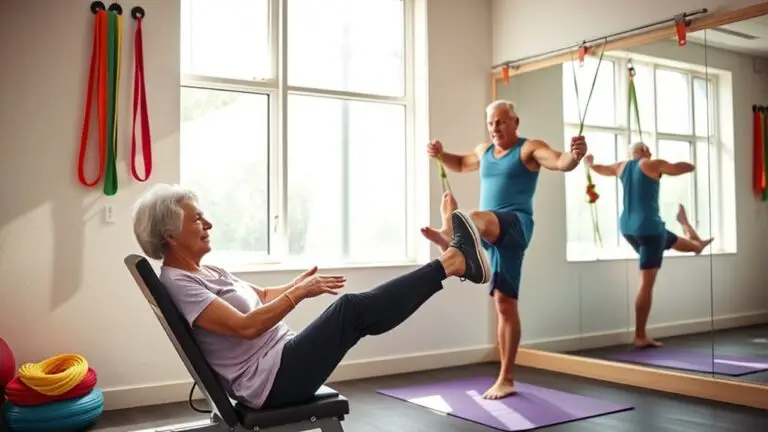Bodybuilding Mistakes to Avoid as a Beginner

As a beginner in bodybuilding, it’s essential not to neglect proper form and technique—this helps prevent injuries. Always warm up and cool down to prepare your body for workouts. Avoid overtraining; rest days are important for recovery. Don’t ignore nutrition; a balanced diet supports muscle growth and performance. Set realistic goals to maintain motivation. Finally, steer clear of relying too heavily on supplements. There’s plenty more to learn to maximize your progress and safety.
Neglecting Proper Form and Technique

When you hit the gym, it’s easy to get caught up in lifting heavier weights, but neglecting proper form and technique can lead to serious injuries. Focusing on proper alignment is crucial for maintaining safety and maximizing muscle engagement. To achieve technique mastery, pay attention to form cues and use exercise variations to keep your workouts effective and safe. You’ll find that prioritizing movement efficiency not only enhances performance but also reduces the risk of strain.
Consider seeking coaching feedback, whether from a trainer or knowledgeable gym buddies. They can help you identify areas for improvement and reinforce good habits. Additionally, performance tracking can be invaluable; by monitoring your progress, you can ascertain that you’re lifting within your capabilities while refining your technique. Remember, lifting smart is just as important as lifting heavy. Prioritize these elements for a safer, more effective bodybuilding experience. Incorporating exercises like Toes to Bar modifications can further enhance your core engagement and overall strength.
Skipping Warm-Ups and Cool-Downs
If you’re skipping warm-ups and cool-downs, you’re missing out on essential steps to enhance your workout. Warm-ups prepare your body for the intensity ahead, while cool-downs help in recovery and flexibility. Ignoring these can lead to injuries that could sideline your progress, so don’t overlook their importance.
Importance of Warm-Ups
Although many lifters might be tempted to skip warm-ups and cool-downs, doing so can greatly hinder your performance and increase the risk of injury. Incorporating dynamic stretching into your warm-up routines prepares your muscles for the workout ahead, enhancing flexibility and blood flow. Here’s a quick overview of key warm-up components:
| Type of Warm-Up | Duration | Benefits |
|---|---|---|
| Dynamic Stretching | 5-10 mins | Increases mobility |
| Light Cardio | 5-10 mins | Elevates heart rate |
| Specific Drills | 5 mins | Prepares muscles |
| Cool-Down | 5-10 mins | Aids recovery |
Always remember, a proper warm-up is essential for a safe and effective training session. Prioritize these routines to protect your body and maximize results.
Benefits of Cool-Downs
Cool-downs are just as essential as warm-ups, as they help your body shift back to a resting state and can greatly reduce muscle soreness. After an intense workout, it’s vital to implement cool down routines to gradually lower your heart rate and relax your muscles. This practice not only promotes recovery but also aids in flexibility improvement, allowing your muscles to maintain a healthy range of motion. Skipping cool-downs can lead to stiffness and discomfort, making it harder to progress in your training. By incorporating a few minutes of gentle stretching and deep breathing post-workout, you’re investing in your overall well-being and ensuring a smoother shift back to your daily activities. Prioritize cool-downs for best results!
Injury Prevention Strategies
Skipping warm-ups and cool-downs can greatly increase your risk of injury. When you don’t warm up, your muscles aren’t adequately prepared for the stress of lifting weights, leading to strains or tears. A proper warm-up raises your heart rate and improves blood flow, making your workouts safer and more effective. After your workout, cooling down helps your body revert back to its resting state, reducing soreness and stiffness.
Incorporating injury assessment techniques during your routine can help you recognize early signs of discomfort, allowing for timely injury management. By dedicating time to warm up and cool down, you’re not just protecting yourself from injury; you’re also ensuring long-term progress in your bodybuilding journey. Prioritize safety—your body will thank you!
Overtraining and Lack of Recovery
Rest days are just as essential as your training sessions, and skipping them can lead to overtraining. You might notice signs like fatigue, decreased performance, or mood swings if you’re pushing too hard without enough recovery. Recognizing these symptoms early can help you avoid setbacks and keep your progress on track.
Importance of Rest Days
While pushing your limits in the gym can feel rewarding, neglecting the importance of rest days can lead to overtraining and hinder your progress. Rest days are vital for muscle recovery, allowing your body to repair and grow stronger. Without proper recovery, you risk injury and fatigue, which can stall your gains.
| Rest Day Benefits | Recovery Importance |
|---|---|
| Reduces muscle soreness | Prevents injury |
| Enhances performance | Improves hormonal balance |
| Boosts mental well-being | Supports immune function |
Incorporating regular rest days into your routine guarantees you reap the full benefits of your hard work. Remember, rest isn’t just a break; it’s an essential part of your training strategy. Prioritize recovery for the best results.
Signs of Overtraining
When you push your body too hard without adequate recovery, you may start to notice signs of overtraining creeping in. Common overtraining symptoms include persistent fatigue, decreased performance, and increased irritability. You might also experience trouble sleeping or a sudden loss of appetite. Take these recovery signs seriously; they indicate your body needs a break. If you find yourself feeling overly sore or your usual workout routine feels overwhelming, it’s a clear signal to reassess your training intensity. Incorporating rest days and lighter workouts can help combat these symptoms. Remember, listening to your body is essential. Prioritize recovery to guarantee you’re training safely and effectively, setting the foundation for long-term success in your bodybuilding journey.
Ignoring Nutrition and Diet

Ignoring nutrition and diet can derail even the most dedicated bodybuilding efforts, as the food you consume plays a crucial role in your muscle growth and recovery. To see real progress, you’ll need to focus on meal planning that aligns with your training goals. This means understanding macronutrient balance—getting the right amounts of proteins, carbohydrates, and fats.
Without proper nutrition, you risk not only stalling your gains but also compromising your health. It’s important to fuel your body with nutritious foods that support your workouts and recovery. Consider tracking your meals to verify you’re meeting your nutritional needs.
Setting Unrealistic Goals
Setting unrealistic goals can hinder your bodybuilding progress more than you might realize. It’s easy to get caught up in the desire for rapid results, but setting overly ambitious targets can lead to frustration and burnout. Instead, focus on goal setting that aligns with realistic expectations based on your current fitness level and experience.
Start with achievable benchmarks, such as gradually increasing your weight or improving your form. Celebrate small victories along the way; they’ll keep you motivated and reinforce healthy habits. Remember, bodybuilding is a marathon, not a sprint.
Relying Too Heavily on Supplements

How often do you find yourself reaching for supplements, believing they’re the magic solution to your bodybuilding goals? While they might offer some benefits, relying too heavily on them can lead to supplement dependency. It’s essential to remember that no pill or powder can replace the hard work you put into your diet and training.
Instead of looking for shortcuts, focus on building a solid foundation with whole foods. Natural alternatives like lean proteins, fruits, vegetables, and whole grains can provide your body with the nutrients it needs to grow and recover. Prioritize a balanced diet, and use supplements only to fill specific gaps when necessary.
Frequently Asked Questions
How Often Should I Change My Workout Routine?
You might say it’s best to keep things fresh and exciting when it comes to your workouts. To avoid hitting a plateau, consider changing your routine every 4 to 6 weeks. This workout frequency helps maintain motivation and encourages progress. Incorporating routine variety not only keeps things interesting but also reduces the risk of injury. Listen to your body, and don’t hesitate to mix it up for ideal results!
What Should I Eat Before and After Workouts?
When it comes to fueling your workouts, pre workout snacks and post workout meals are essential. Before hitting the gym, opt for something light, like a banana or a small protein shake, to give you energy without weighing you down. After your workout, focus on a balanced meal with protein and carbs, like grilled chicken with quinoa or a protein smoothie, to aid recovery and help your muscles rebuild safely.
Is It Okay to Lift Weights Every Day?
It’s great that you’re enthusiastic to lift weights, but lifting every day might not be the best approach. Your muscles need time to recover after intense workouts, so consider incorporating rest days into your routine. Weightlifting frequency should ideally allow for muscle recovery, which helps prevent injuries and promotes growth. Listen to your body; if you feel fatigued, take a break. Balancing workouts with recovery is key to long-term success.
How Can I Measure My Progress Effectively?
To measure your progress effectively, start by tracking your body composition regularly. You can use methods like skinfold calipers or bioelectrical impedance scales to get an idea of your muscle versus fat ratio. Keep a workout log to note weights and reps, helping you see strength improvements over time. Don’t forget to take progress photos; they can be motivating. Remember, consistency is key, so be patient and focus on gradual changes.
Should I Work Out if I’m Feeling Sore?
If you’re feeling sore, it might seem like you’re turning into a walking, talking pretzel! While some soreness is normal, you shouldn’t push through intense discomfort. Focus on soreness management instead. Light workouts or active recovery can help, but listen to your body. Prioritize workout recovery to avoid injury. If the pain feels sharp or excessive, it’s best to rest. Remember, progress comes from smart choices, not just sheer determination!





